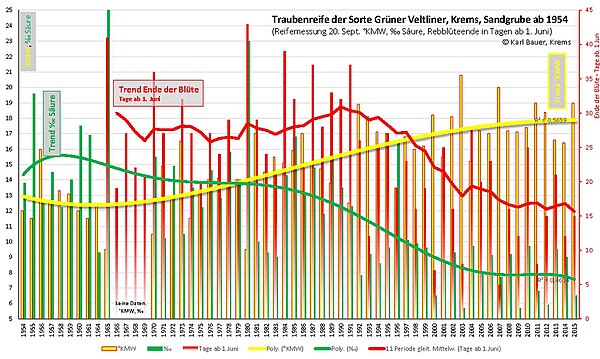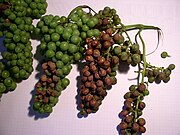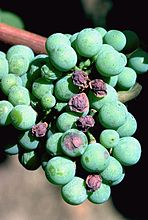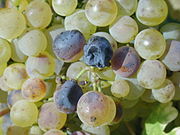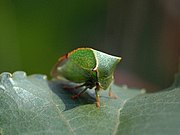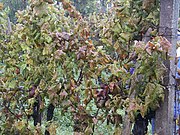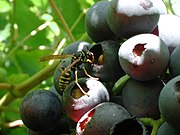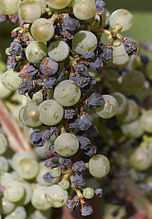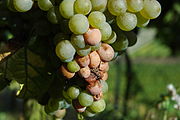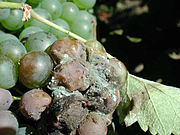Effects of global warming on viticulture
The consequences of global warming also include changes in plant development. The vine as a heat-loving plant is affected. The consequences of global warming on viticulture can have a positive or negative effect and can vary from region to region.
Solar radiation , water , soil ( minerals ) and location ( exposure ) represent the spatial environment of the vine. Like every cultivated plant , the vine requires special climatic conditions. On the one hand, it has high climatic requirements, but has, depending on the variety and substrate, a good ability to adapt to changing conditions. Some varieties have a wide range of cultivation and others, mostly autochthonous varieties, a narrow one. In other words: these varieties developed slowly under specific conditions of the terroir and adjusted to these conditions so that they can develop their regionally typical wine quality. Global warming can have a very negative effect on these varieties in particular.
Weather fluctuations affect the quantity and quality of the wine . This is why there are typical year- old differences . The global warming that has already taken place, as well as the expected further global warming, have an impact on development, duration of vegetation, range of grape varieties, yield, grape quality, berry ingredients, foliage, yield regulation, soil care, plant protection measures, the appearance of new harmful organisms and grape processing. Both positive and negative consequences have already occurred and are to be expected.
Effects of global warming
The greatest effect of global climate change comes from the rise in temperature , which has so far had a beneficial effect on ripening in the northern wine-growing regions of Europe. Temperature, along with a number of other factors, determines the development of the vine.
Phenological development
Rising temperatures accelerate growth, falling temperatures delay it. Mild winters, warm springs and hot summers accelerate phenological development. The development can be described with temperature sums. The mean heat sum per day in 2010 is 1.5 ° C higher than in 1950. This additional heat sum accelerated development by at least 14 days. The forward shift in development is particularly evident in the period from April to June and July to August. Scenarios suggest a further increase in total heat.
Shoot, duration of vegetation
Due to global warming, the growing season for plants, including the vine, is being extended. Observations of the Riesling variety in Geisenheim show that budding begins 5 days earlier than the average for the last 40 years (from 1970). With the expected temperature increase of 2 ° C over the next 50 years, this trend will continue. In Veitshöchheim near Würzburg , budding of the Müller-Thurgau variety can be observed 8 days earlier. This gives her a longer period of time for growth and development. The records for the Müller-Thurgau variety show, however, that this variety only reduced its vegetation period by around 5 days to 158 days in the period 1988–2002. Müller-Thurgau does not use the extended vegetation period to store more sugar in the berries, but rather completes the grape ripeness when a certain degree of ripeness is reached. Varieties that ripen later, such as Silvaner , Grüner Veltliner , the Burgundy varieties and Riesling, can make better use of the extended vegetation period.
Vines
In the period from budding to blooming, the vine reacts particularly to the temperature profile in May with the development of the shoot and leaf area. Depending on the weather, the start of flowering will be earlier or later. It is not dependent on the budding of the vines. The temperature also has a major influence on the fertilization process and the duration of the vines' flowering. The berry development begins with flowering, the timing of which is decisive for the grape ripeness. These relationships result from the recordings of the vines in the period from 1965 to 2011 at the Krems an der Donau site ( 48 ° 24 ′ 39 ″ N , 15 ° 36 ′ 37 ″ E ), and also the analysis on an over 50 year old Phenological series for the Riesling variety in Geisenheim / Rheingau ( 49 ° 59 ′ 4 ″ N , 7 ° 58 ′ 2 ″ E ). There is a clear shift of the vines at the Krems site in June by approx. 11-14 days.
An early flowering (1993, 2000, 2003, 2007) means that ripening begins earlier. In years like this, the grapes have a higher sugar content. A very late flowering (1965, 1980) also meant that the grapes ripened late. There is a high correlation between the end of flowering and the beginning of ripening, as shown by ripening measurements in Krems for the Grüner Veltliner variety and in Geisenheim for the Riesling variety . Recordings of the reading date from Schloss Johannisberg in the Rheingau from 1750 onwards show an ever earlier reading date for the Riesling variety. Scenarios show a further 10 days of readiness by 2100.
The illustration shows the grape ripeness of the Grüner Veltliner variety (Weinbauschule Krems, Lage Sandgrube ) from 1954 to 2015. The ripening measurements were made on September 20 of each year (± 1 day) - data in ° KMW . In 2007 the values were affected by severe hailstorms . The diagram also shows the trend in the flowering of the Grüner Veltliner variety from the same location (flowering in days from June 1st). The influence of climate change, in the illustration that has been running for a good six decades, is clearly visible.
Leaf area
As a result of global warming, the lengthening of the vegetation period and the increase in the total amount of heat mean that the same photosynthesis can be achieved with a smaller leaf area. A small leaf area results in a smaller evaporation area and thus lower water consumption. Comparisons have shown that at the 50th degree of latitude (Geisenheim) a vine located at the 30th degree of latitude requires almost twice the leaf area in order to be able to provide the same photosynthesis performance. This gives the possibility of reducing the leaf area with increasing heat sum. This reduces the growth of the shoots and reduces the transpiration of the vine leaves. In the future, lower canopy heights may be sufficient due to increasing global warming. Since the annual differences fluctuate significantly in the northern wine-growing regions, this is currently not an option.
temperature
Extreme temperature
With global warming, the frequency of extreme temperatures has increased. This shows the increase in the number of tropical days (days with temperatures above 30 ° C); these are increasing every year. On these days, the temperature can rise in areas where there is a negative impairment of functions or direct damage to leaves and berries. In the latter case, one speaks of sunburn . The risk of sunburn depends very much on the weather. The risk potential is particularly great when the following situation occurs:
- good water supply
- a hot spell with very high temperatures after a cool spell
- very low humidity and high saturation deficits for water vapor
The damage caused always depends on the time of the occurrence of the extreme temperatures and the stage of development of the vine. Extreme temperatures occur most frequently in the period from late June to early August. Rapid spring development, especially immediately after the vines have blossomed, can lead to less hardening of the young berries and thus to an increased risk of sunburn. In the ripening phase, extreme temperatures have a marked influence on the malic acid . Temperatures of over 40 ° C lead to a drastic decrease in malic acid in the berries. Berries damaged by sunburn should be eliminated before further processing.
Late frost
The occurrence of late frosts is very different in the vineyards, depending on the terrain. The comparison period is still too short for the assessment of an increased risk of late frost due to the warming that has taken place.
The Geisenheim climate scenario from 2001 to 2050 confirms the assumption for the Rheingau that the risk of frost will not increase despite the early budding. But there will always be late frosts. Even warmer climates in the Mediterranean area will occasionally be afflicted by the ingress of cold air after the early budding of devastating late frost damage.
See also: Frost damage (viticulture)
hail
No trends can currently be identified with regard to hail frequency.
UV-B radiation
Towards the end of the last century, the ozone concentration in the upper atmosphere decreased. As a result, the cell-destroying UV-B radiation is filtered less, it increases and influences the development of the vine. Ozone has no effect on the greenhouse effect , but it does on the vines. Due to the increasing UV-B radiation, unfavorable tannin deposits in the berry skins can have a negative effect on the quality of the wine. Tests with absorber film in Geisenheim (tests with the Riesling variety ) showed that the grapes shaded with these films contained more green than yellow colorants. They were delayed in maturity and those not shaded had sunburn damage. Interestingly, the wines made from shaded grapes were preferred in the context of a panel of examiners. From today's point of view, film covers are out of the question for practical use because of the high costs and the considerable obstacle to management.
The opposite results are known from New Zealand, where UV-B radiation is 50% stronger than in Austria. After trying the Sauvignon Blanc variety , the burnt grapes are, so to speak, the ones that make the better wine. In 2019, the heat wave in the southern French wine-growing regions of Gard , Hérault and Var caused “burn marks” on the grapes and thus production losses.
Wine quality
The premature development is of major influence, especially for the ripening phase, which takes place at higher temperatures, which has a lasting effect on the formation of ingredients. Global warming has so far proven to be beneficial for red and white wine varieties, with a few exceptions in certain years, but may become even more pronounced in the future, especially for white wine varieties e.g. B. have a negative effect through excessive acid degradation, early botrytis infestation, green or vinegar rot infestation. Wine quality has already developed into more mature, extract and alcohol-rich wines. The warmth-loving red wine varieties have benefited most in the northern growing areas. Early ripening grape varieties will increasingly have problems in the future because the harvest takes place in an extremely warm period.
In addition to the must weight, an essential basic parameter is the acidity. The degradation of the acid is mainly determined by the temperature during the ripening period. The most important process is the breakdown of malic acid . The degradation of malic acid has a greater effect, especially in the best locations. For the taste of a wine it is very important for the freshness of the wine. The premature ripening can result in a too low acid content as well as a reduced aroma expression due to too fast ripening. The trend towards less acidic wine is not only noticeable up to now, but will also continue. The warm slopes are particularly affected.
The production of ice wine is made more difficult by global warming , as the not so low early winter temperatures can be insufficient.
Range of grape varieties
Earlier shoots, earlier vines and earlier grape ripeness result in a longer period for berries to develop. Varieties with a higher heat requirement also reach maturity in the same position. Pierre Huglin developed a bioclimatic heat index for the wine-growing regions, in which the temperature sum above the temperature threshold of 10 ° C is calculated and this is added up from April to September. Both the daily mean temperature and the maximum temperature are used in the calculation and the calculated sum is slightly modified with the geographical latitude. Each grape variety therefore requires a certain amount of heat in order to be successfully cultivated in an area in the long term. The calculated heat sums, which are based on data from weather stations, differ from the actual values in the vineyards because the sums are too low. The index does not take into account the thermally favored vineyard slopes, the temperature of which can be around 1.5–2 ° C higher. Over the next few decades the Huglin index will continue to rise; H. further change the suitability of an area for grape varieties.
| Huglin index H. | Grape varieties |
|---|---|
| 1500 <H | no cultivation recommendation |
| 1500 ≤ H <1600 | Müller-Thurgau , Blue Portuguese |
| 1600 ≤ H <1700 | Pinot Blanc , Burgundy Gray , Aligoté , Gamay Noir , Gewürztraminer |
| 1700 ≤ H <1800 | Riesling , Chardonnay , Silvaner , Sauvignon Blanc , Pinot Noir , Grüner Veltliner |
| 1800 ≤ H <1900 | Cabernet Franc , |
| 1900 ≤ H <2000 | Chenin Blanc , Cabernet Sauvignon , Merlot , Semillion , Welschriesling |
| 2000 ≤ H <2100 | Ugni Blanc |
| 2100 ≤ H <2200 | Grenache , Syrah , Cinsaut |
| 2200 ≤ H <2300 | Carignan |
| 2300 ≤ H <2400 | Aramon |
With the increase in the total heat, the range of grape varieties in the northern growing areas has already changed. Varieties that were previously only cultivated in wine-growing regions to the south have already achieved a certain importance in cultivation in Austria and Germany. The varieties Cabernet Franc , Cabernet Sauvignon , Merlot and Syrah are already being planted and successfully cultivated in the warmer regions of Austria . They have already been included in the quality grape range.
Wine region
Due to the earlier grape ripening and thus the harvest, there is greater scope for achieving certain quality levels . The growing areas suitable for viticulture are becoming larger and the later ripening and higher-lying areas are more suitable. The viticultural cultivation limit moves north. If the further trend of rising temperatures continues, the potentially possible cultivation limit for vines shifts by 200 to 400 km northwards and by 100 to 150 m upwards. The extensive wine-growing regions in Italy and Spain would be particularly badly affected. Overall, the area under vines could decrease by at least half.
Locations that until the end of the last century were called late ripening have come into a more favorable situation for the vines due to global warming. This also applies to higher altitudes. In the future, these locations will be able to deliver those wines - this applies particularly to white wines - that have a good acid structure and can be used for blending with wines from earlier locations.
Soil water balance
In addition to light and warmth, water is a very important nutrient element for all plants , which should be available in doses according to the season. The annual precipitation distribution is only known from locations with a weather station. Due to the type of precipitation and especially the terrain, the local differences in the amount and distribution of precipitation can be large. Precipitation during the growing season (April to October) is decisive for the vines. The very large annual differences in the amount of precipitation and its distribution lead to strongly changing situations in the water balance in the individual years. Depending on the water storage capacity of the soil, the vine can adapt relatively well compared to other plants. In any case, the constantly changing water supply in the soil is a major stress factor. As with all plants, the nutrients in the soil can only be used if they are dissolved in soil water. Vines can use the smallest of water supplies, as their suction power reaches up to 1.6 mPa and the roots, if the soil allows it, grow to a depth of 10 m.
With global warming, the amount of water available for the vines and its distribution have become less favorable. With increasing solar radiation, temperature and wind speed as well as decreasing relative humidity, the evaporation demands of the atmosphere increase. The mean potential evaporation during longer dry periods in summer has increased in recent years . While the values in Geisenheim in 1950 were still 28 mm, the trend today exceeds the threshold of 62 mm. The water deficit is very different from region to region. The soil and soil care will be even more important in the future with regard to the water balance.
Increasing drought and dry periods during the growing season have a particularly negative impact on the quality of white wine varieties. The water balance of the vine plays a decisive role in the development of quality features (typicality) in the northern growing areas. With the establishment of water-saving irrigation systems in the form of drip irrigation , the negative consequences can be counteracted.
The increased occurrence of heavy precipitation events increases soil erosion and thus impairs the soil's ability to store moisture.
Due to global warming, vines are increasingly exposed to drought stress . Drought stress leads to a poor and inharmonious supply of nutrients, which in combination with insufficient fertilization ( potassium , unfavorable K / Mg ratio, organic and mineral fertilization) and other as yet unknown factors can promote grape wilt. The causes of grape wilt are complex.
Increasing drought makes the cultivation of green plants to improve the soil and reduce erosion significantly more difficult. Drought stress (water stress) not only leads to a higher water consumption of the vine (varietal differences exist), but also in the case of the greening plants due to transpiration and in the soil with the evaporation . The timely detection of water stress (drought stress) is important in order to be able to optimally control and design soil maintenance measures and irrigation systems. Today, besides the individual observation of the vines, measurements up to the calculation of the soil moisture are available. Water stress symptoms show up early on in the vines with the stretching of the tendrils. Soil moisture measuring devices that are used in fruit and vegetable growing are not suitable for viticulture. A good method to provide support is to determine the water balance and calculate the soil moisture. Weather services make appropriate offers here. Much better, but more time-consuming, is the early morning leaf water potential measurement with the Scholander bomb . Here the vine is asked what condition it is in, so to speak.
Higher temperatures in the soil also lead to a change in the rate of decomposition of organic material, which makes an increased supply of organic fertilizers necessary.
| Effects of water stress in the maturation phase | Adapted water supply based on the vine stages |
|---|---|
| Premature yellowing of leaves, reduced fabric production, emergency ripening | High water use efficiency |
| Considerably reduced reserve material storage | Limited leaf area and amount of wood |
| Lower volume yield, low acid values, possibly also lower must weights | Extension of the ability of the leaves to assimilate substance production in favor of the generative organs |
| Severe lack of extracts and amino acids | Sufficient amount, balanced sugar / acid ratio |
| In white wine varieties, lack of aromas and undesirably high phenol contents | High conversion rate into valuable ingredients |
| Strong tendency towards missing tones in white wine | Avoidance of missing tones |
| Inclination in white wine to atypical aging (UTA) | Improvement of the fermentation process |
| Insufficient nitrogen supply and fermentation problems | Higher aging potential |
| White wine tastes bitter, astringent, dull, short | Preservation of distinctive taste and aroma profiles, greater sustainability |
Harmful organisms
Global warming favors the occurrence, survival and spread of harmful pathogens in the northern vine-growing areas. The damage potential of already existing harmful organisms can increase. Pathogens that previously only appeared in more southerly areas are now already occurring in northern areas as harmful organisms, such as phytoplasms , cicadas , thrips , viruses, nematodes , Esca and Petri disease. Furthermore, the number of generations of harmful pathogens (e.g. a third generation of the grape moth) can change. Yellowing diseases are caused by phytoplasms that are pathogenic to vines . Phytoplasmas are microorganisms that suckle insects, such as. B. winch Glasflügelzikade ( Hyalesthes obsoletus ) or Scaphoideus Titanus ( Scaphoideus titanus ) are transmitted. The glass-winged cicada is particularly heat-loving and immigrated to the more northern wine-growing regions towards the end of the last century. It only occasionally transmits blackwood disease (BN) . The damage caused by blackwood disease is nowhere near as serious as the damage caused by golden yellowing ( flavescence dorée ), which is transmitted by the American vine leafhopper. The golden yellow yellowing leads to the death of the vines. Infestation can only be avoided by combating the vector in order to prevent or contain the spread. This small cicada lives on the vines and has been known for a long time in Serbia, Slovenia, northern Italy and southern Switzerland. The occurrence was noted for the first time in 2009 in southern Styria and 2010 in southern Burgenland. The quarantine disease spread by her (first appearance in southern Styria 2010) is notifiable. Corresponding control measures and clearing of vineyards are officially ordered. With the occurrence, an epidemic spread of this disease is possible. According to the Styrian Plant Protection Act, appropriate countermeasures must be taken. The occurrence of this disease is not only associated with direct damage, but also with serious lasting effects on integrated and biological viticulture systems.
Harmful organisms find changed development conditions, even though they have not yet appeared harmful. For example, the fungal disease introduced to Europe in the 19th century, the so-called black rot ( Guignardia bidwellii ), has only now appeared damaging in some wine-growing regions in Germany and Austria. Only the warm, humid weather conditions in spring enabled the fungal disease to develop. In this disease, however, the culture conditions also play a role, because a high potential for infection develops particularly in vineyards that are no longer cultivated. In the future, it cannot be ruled out that a bacterial disease will also establish itself in Europe, such as Pierce's disease caused by Xylella fastidiosa . The bacteria from the Xanthomonadaceae family are transmitted by cicadas that suckle xylem. The risk is currently low; the risk only increases as the temperature increases. The disease has not yet been proven beyond doubt in Europe.
Buffalo Fikada ( Stictocephala bisonia )
Buffalo fikada - leaf color change above the punctures on the shoot
The bindweed glass-winged cicada ( Hyalesthes obsoletus ) is the carrier of blackwood disease
Blackwood disease - infected vine with dried up grapes and chlorotic leaves
Flavescence dorée - infested vine with very advanced leaf symptoms
Flavescence dorée - instinctual symptom
Flavescence dorée - leaf symptom
Black rot attack on a grape
Due to the early development, the grapes ripen in an even warmer season. The warmer and more humid the weather, the easier it is for botrytis and Penicillium expansum (green rot) to attack the berries. Further possible putrefactive fungi and their mycotoxins are listed in the table. The increased occurrence of these harmful organisms caused by the removal of infected berries, a significant additional work in the grape harvest. Otherwise, quality losses are inevitable.
| Pathogen | Surname | Mycotoxin |
|---|---|---|
| mushroom | ||
| Botrytis cinerea | Botrytis , gray rot , sour rot | |
| Aspergillus ssp. | Cabbage black rot , watering can mold | Ochratoxin A. |
| Penicillium ssp. | (Blue) green mold, bacon rot | Patulin |
| Alternaria ssp. | Alternaria rot | Alternariol |
| Rhizopus ssp. | Rhizopus rot | |
| Trichothecium ssp. | Pink rot | Trichothecenes |
| Mucor sp. | Mucor rot | |
| Guignardia bidwellii | Black rot | |
| bacterial | ||
| Acetobacter | Vinegar rot |
Cherry vinegar fly ( Drosophila suzukii ) male. Frequent mild winters favor the overwintering of this new pest, which attacks various red wine varieties.
Adaptation strategies
The negative effects of global warming can be counteracted more or less effectively and in some cases not at all with various measures. There is no simple solution. Certain measures can be beneficial in one year but disadvantageous in other years. The winemaker is challenged more than in the past to adapt to the different situations every year. After extreme years in terms of temperature and precipitation, years with opposite values follow.
Planting a vineyard
The vine is a perennial cultivated plant. A vineyard is used for around 30–40 years. During this period, it is no longer possible to adapt to the slowly changing global warming when selecting the variety (with refinement possible) and rootstock or when enriching the subsoil with nutrients. The winemaker cannot be flexible here, but only when setting up a new vineyard. When setting up a new vineyard, fundamental decisions are made that cannot be changed or can only be changed with great difficulty within the useful life.
Nutrient supply
In the case of a new plant on a dry site, it is particularly important to ensure sufficient enrichment with nutrients. The nutrients should be brought into the deeper soil layers. A harmonious supply of nutrients to the soil with a good supply of humus is the prerequisite for good development of the vines, especially in increasingly stressful situations. With water stress, the absorption of nutrients is reduced. The nutrient potassium has a key position in the vine with regard to the water supply. Even a slight (hidden) potassium deficiency increases water consumption. It is therefore important to have an optimal supply of potassium in the entire root horizon in order to better survive this time in the event of increased water stress. Especially in the summer months, i.e. when the grapes are ripe, the need for potassium increases significantly, and summer dry periods can have a more or less unfavorable effect on the ripening process of the grapes.
Variety choice
When choosing a variety, marketability is of crucial importance. This criterion will not change in the near future. A grade change in an existing plant is possible with refinement. There are differences in the selection based on drought resistance for both red and white wine varieties. Cabernet Sauvignon and Chardonnay , for example, are less sensitive to drought stress than Zweigelt and Grüner Veltliner . Drought stress can best be counteracted with irrigation. The combination with the rootstock also plays a decisive role in the drought resistance of a grape variety. A certain delay in maturity can be achieved with the choice of clones. For example, looser clones of the Blauer Burgunder (Spätburgunder) variety , the Mariafeld M1 clone or the Freiburg L clones can be harvested later due to their higher yields. The most important advantage of the loosely berried clones is the improved health of the grapes in the form of less susceptibility to rot. Many research institutes are currently looking for such clones. For the farms, however, no loose clones are available for the majority of the varieties. The goal of looseness will not be achieved with all varieties. New breeds also give a certain potential in terms of drought resistance, looseness and disease resistance.
Document choice
In the past it was important to choose the root variety to premature the ripening of the noble variety, today one looks for a combination that delays the ripening. The drought resistance of the underlay is decisive. The range of rootstocks is large, and there are special rootstocks for different site conditions. With the rootstock varieties used in Austria and Germany today, no delay in ripening can be achieved. The rootstock varieties of the cross Vitis Berlandieri x Vitis Rupestris, such as Richter 110, Paulsen 1103, 140 Ruggeri, which are used today in southern areas, allow a delay in ripening. These types of underlay have not yet been approved in Germany. In Austria, use is not tied to any authorization in this regard. These types of rootstock are more drought-tolerant, have a higher water acquisition capacity and are therefore better adapted to changing climatic conditions. Disadvantages are the often very vigorous growth and the lack of years of experience in northern growing areas on different soil conditions. The rootstock varieties Börner and Fercal, which do not belong to the group of Vitis Berlandieri x Vitis Rupestris hybrids, are well suited for a high drought tolerance .
Educational system
The vein education system has to meet various tasks. For cost reasons, mechanization has been in the foreground in the last few decades. It is clear that systems where the grape zone is grown very close to the ground, the grape ripening occurs earlier. With global warming, the grape zone can be placed higher in more northern growing areas. This is also an advantage in terms of a lower incidence of putrefactive fungi. The level of yield has an early or retarding effect. All measures that reduce the yield have a ripening effect. Education systems that provide high returns on average, such as B. the minimal cutting training, have a ripening-retarding effect.
Maintenance work
A number of quality-enhancing measures, such as yield regulation , moderate partial defoliation, the use of phytohormones , short pruning , creating an optimal leaf-fruit ratio, promote ripening. In the future, measures to delay maturity will be required. From today's perspective, the maintenance work mentioned would be counterproductive in the future.
Canopy work
Due to the progressive climate change, the tasks and goals of canopy work have not fundamentally changed. Achieving these goals, however, sometimes requires a different approach than before. What was good and optimal towards the end of the last century requires a corresponding annual adjustment due to the increasing climatic variability. What was optimal then is not necessarily what is useful today. Moderate early thinning of the grape zone 1–3 weeks after flowering is particularly important. The increasing variability of the weather is a problem. It complicates a professional approach. Berries are less at risk from sunburn if they are released soon after flowering. The UV radiation leads to a thickening of the berry cuticle and allows the wax layer to grow. The wax layer protects the berries from UV radiation. In the period of rapid berry development - the high temperatures accelerate the vegetative and generative development - the aforementioned effect including the storage of flavonoids can be too small and sunburn damage can occur despite early exposure. The grapes should therefore be exposed early and very moderately, on the east side of the foliage wall (with north-south line) and on the north side with east-west line, in order to protect the grapes from the highest daytime temperatures. This procedure is very important, especially with white wine varieties. Since early partial defoliation of the grape zone tends to promote ripening, intensive late defoliation ( ES 75 to ES 81 ) can delay ripening. The occurrence of putrefactive fungi is also reduced. Excessive defoliation has a positive effect on botrytis infestation , but has a very negative effect on changes in aromas in white wine varieties. For example, the Silvaner gets smoky aromas due to its high cinnamic acid content and Riesling has a petrol note .
Floor care
Based on the explanations under the point soil water balance , the strong increase in potential evaporation in July and August results in an increased need to adapt the soil maintenance system to the site conditions. Here, too, what worked twenty or more years ago is no longer possible today. Towards the end of the last century, various types of greening became widely accepted in the northern wine-growing countries. From the end of the last century, soil maintenance had to be more or less adapted to the changed climatic situation, depending on the precipitation and the given soil conditions. Greening is to be reduced to such an extent, except if there is a possibility of irrigation or to restrict its development, so that the water consumption of the greening plants is as low as possible, but on the other hand sufficient benefits of greening (erosion protection, humus enrichment, etc.) are retained. Particular attention must be paid to white wine varieties, as these varieties react to water stress with poor wine quality. The supply of organic matter (humus fertilizer) for humus enrichment (increasing the water storage capacity) and soil cover with suitable materials (e.g. straw) is more important today than it used to be. These possibilities often fail because straw and other organic materials are not available in the intensive vine-growing areas / or are insufficient to adequately supply all areas. A certain delay in ripening can be brought about by covering the ground with various organic materials (straw, green chaff, bark mulch). These materials improve the soil structure, the rooting capacity and the nutrient supply, and what is very important today, the water storage capacity of the soil is improved in the long term.
Plant protection
The changed occurrence of harmful organisms must be counteracted accordingly with adapted plant protection methods. The fight against putrefactive fungi is particularly important. Delaying the ripening process with certain plant protection products is not possible in terms of the correct use of the plant protection products.
Cellar management measures
Excellent wines can only be made from the best grapes.
reading
Grape's own processes, d. H. Conversion or degradation of various ingredients are dependent on the temperature. Therefore, on hot days, the grapes must be harvested in the cool night or morning hours. This has been practiced for a long time in cultivation areas to the south. Immediate cooling of the brought in grapes is another possibility. The quality of the grapes changes with the increased occurrence of drought stress. The grapes are subject to emergency ripening. Such processed grapes have analytical and sensory problems in the later wine.
Sorting of grapes
Due to the occurrence of green and vinegar rot and other putrefactive fungi, the need to sort grapes will become increasingly necessary in the future. This work is carried out during the harvest in the vineyard or before processing in the cellar. There are various grape or berry sorting systems.
Pressing
Increased tannin content in the berry skin should, on the one hand, be avoided by extraction through particularly gentle processing, and on the other hand, timely and optimal tannin treatment in the must.
High temperatures during the grape harvest promote the conversion or breakdown of various constituents of the berries. Certain flavor aromas are very sensitive to oxidation, such as B. Sauvignon Blanc . Measures that slow down the grape's own processes are therefore particularly important.
A reductive processing should be aimed for with sensitive varieties. Measures to maintain or positively influence the aroma, such as cool fermentation, are quality-critical.
enrichment
Due to global warming, grapes reach a sufficient sugar content almost every year, so that enrichment with sugar is no longer necessary. In the past, the enrichment was carried out almost annually. Today's average higher sugar content in grapes leads to higher alcohol content in wines, which is not always desired. Good cellar management measures, cooled and controlled fermentation, also reduce alcohol and aroma losses during fermentation. The search for yeasts , which produce less alcohol from sugar, has begun. There are possibilities of alcohol withdrawal and these are also used, depending on the legal regulations. On the other hand, devices for dehydration and for increasing the must sugar content are becoming less important.
Acid correction
Until the end of the 20th century, the must or wine had to be deacidified in some years, but this is now only possible in exceptional cases. In contrast, acid must be added in very early years, which is a routine in the cellar in the warmer growing areas. If the acidity is reduced too much, the acidity can be increased by adding acid (= acidification of the wine). Carrying out a very early harvest is not a suitable method of maintaining the natural acidity in the must. The EU winegrowing countries are authorized to grant an exemption for the acidification of must and wine, provided that the climatic conditions lead to widespread low acidity levels.
See also
- Consequences of global warming in Germany
- Consequences of global warming in Austria
- International working group for soil cultivation and quality management in viticulture
- Water balance of plants
literature
- Herbert Formayer, Sepp Eitzinger, Helga Nefzger, Stana Simic, Helga Kromp-Kolb: Effects of climate change in Austria. What can be deduced from previous studies. Vienna 2001.
- Dieter Hoppmann: Terroir, Weather - Climate - Soil. Verlag Ulmer, Stuttgart 2010, ISBN 978-3-8001-5317-6 .
- Advisory board for soil fertility and soil protection at the BMLFUW: Guidelines for appropriate fertilization in viticulture. 1st edition. 2003.
- Karl Bauer, Ferdinand Regner , Barbara Schildberger: Viticulture. 9th edition. avBook published by Cadmos Verlag, Vienna 2013, ISBN 978-3-7040-2284-4 .
- Otmar Harlfinger: Climate manual. Part 2, 2002, ISBN 3-7030-0376-6 .
- Helga Kromp-Kolb, Herbert Formayer: Black Book - Climate Change. ecowin Verlag, 2005, ISBN 3-902404-14-0 .
- IPCC Assessment Report (AR4): Climate Change 2007. Fourth IPCC Assessment Report .
- Adel Fardossi, HBLA / BA Klosterneuburg: Physiological investigations on wine cultures with special consideration of stress factors as a probable trigger of grape wilt. 2007.
- Karl Bauer, Adel Fardossi: Effects of climate change on viticulture - a challenge in the future. Part 1, In: Der Winzer 5/2008 [13] ; Part 2. Take countermeasures in good time. In: The winemaker. 6/2008 [14] .
- Karl Bauer, Weinbauschule Krems an der Donau: Phenological records. Results of test pressings .
- Helga Kromp-Kolb, University of Natural Resources and Life Sciences : Climate change and its effects on viticulture. Lecture Gr. Riedenthal Wine Day, Feb. 2008.
- Central Institute for Meteorology and Geodynamics : Austria's Climate in the Last Millennium.
- Josef Eitzinger, Kurt Christian Kersebaum, Herbert Formayer, University of Natural Resources and Life Sciences: “Agriculture in Climate Change” - Effects and adaptation strategies for agriculture and forestry in Central Europe. 1st edition. Agrimedia, 2009, ISBN 978-3-86037-378-1 , pp. 293-299.
- HR Schultz, M. Hofmann, G. Jones: Viticulture in Climate Change: Regions in Transition. Climate status report 2009 [15] (PDF; 510 kB).
- Daniela Dejnega: Viticulture all over Austria? In: The winemaker. 6/2013, pp. 23–25, Österreichischer Agrarverlag, Vienna.
Web links
- Lectures on the effects of climate change on viticulture
- Manfred Stock: Changes in the climate and effects on European viticulture . Potsdam Institute for Climate Research, lecture in Breisach 2006 (PDF; 7.1 MB).
- Stefanie Michel: New strategies in viticulture due to climate change? Bavarian State Institute for Viticulture and Horticulture (PDF; 377 kB).
- Climate change in viticulture. Lecture series of the LK NÖ, Der Winzer No. 3/2010.
- International working group for soil cultivation and quality management in viticulture - conference reports
- Viticulture in (climate) change - sustainability portal of the BMLFUW, Austria
- Weinklim - Viticulture in the face of climate change: Adaptation and mitigation options using the example of Traisental
- E. Burger et al. a .: Starting points for reducing greenhouse gases. In: The winemaker. 06/2010, pp. 10-13 (PDF; 624 kB).
- Vivian Zufferey: The climate stresses the vine. Agroscope Changins-Wädenswil ACW research station, 2009.
Individual evidence
- ↑ Dieter Hoppmann: Terroir, Weather - Climate - Soil. Verlag Ulmer, Stuttgart 2010, p. 248.
- ↑ Marco Hofmann, Dieter Hoppmann, Hans R. Schultz: Influence of climate change on the phenological development of the vine and the acid structure of the grapes. FA Geisenheim, PP lecture presentation [1] (PDF; 2.9 MB)
- ↑ Hans Reiner Schultz , Dieter Hoppmann, Marcon Hofmann: The influence of climatic changes on the phenological development of the vine, the suitability of the variety as well as must weight and acid structure of the grapes. Contribution to the Integrated Climate Protection Program of the State of Hesse (InKlim 2012) of the Viticulture Department of the Geisenheim Research Institute , Geisenheim 2005, p. 12 f./32 ff. (PDF file; 2.9 MB)
- ↑ a b Petra Hönig, Peter Schwappach: Climate change: How does the vine react? In: Vine & Wine. 11/2003. (online at: lwg.bayern.de ) ( Memento of the original from September 20, 2011 in the Internet Archive ) Info: The archive link was inserted automatically and has not yet been checked. Please check the original and archive link according to the instructions and then remove this notice.
- ↑ Dieter Hoppmann: Terroir, Weather - Climate - Soil. Verlag Ulmer, Stuttgart 2010, ISBN 978-3-8001-5317-6 , p. 35.
- ↑ Karl Bauer: Effects of climate change on the ripening process of vines. Report of the ALVA Annual Meeting 2004, p. 84.
- ↑ Marco Hofmann, Dieter Hoppmann, Hans R. Schultz: Influence of climate change on the phenological development of the vine and the acid structure of the grapes. FA Geisenheim [2] (PDF; 2.9 MB)
- ↑ Matthias Petgen: Possibilities and limits of ripening control - How flexibly does the vine react? 60th Weinbautage 2007 Archive link ( Memento of the original from June 22, 2013 in the Internet Archive ) Info: The archive link was inserted automatically and has not yet been checked. Please check the original and archive link according to the instructions and then remove this notice. (PDF; 93 kB)
- ↑ Dieter Hoppmann: Terroir, Weather - Climate - Soil. Verlag Ulmer, Stuttgart 2010, ISBN 978-3-8001-5317-6 , p. 35.
- ↑ Marco Hoffmann, Dieter Hoppmann, Hannes R. Schultz: Influence of climate change on the phenological development of the vine and the acid structure of the grapes. FA Geisenheim, DDW Geisenheim, lecture 2007.
- ↑ M. Stock, F. Badeck, F.-W. Gerstengarbe, T. Kartschall, PC Werner: Viticulture and climate - a relationship of mutual variability. Potsdam Institute for Climate Research , 6th German Climate Conference, Terra Nostra 2003/6, pp. 422–426.
- ^ Karl Bauer, Ferdinand Regner, Barbara Schildberger: Viticulture. avBook published by Cadmos Verlag, Vienna, 9th edition. 2013, ISBN 978-3-7040-2284-4 , p. 47.
- ↑ Hellmut Düring, Horst D. Mohr: "Sunburn" in grapevines - harbingers of climate change? 1/2000 research report [3] (PDF; 2.3 MB)
- ↑ HR Schultz: Sunburn - Riesling in Climate Change. 2008 Archive link ( Memento of the original from July 14, 2014 in the Internet Archive ) Info: The archive link was inserted automatically and has not yet been checked. Please check the original and archive link according to the instructions and then remove this notice. (PDF; 110 kB)
- ↑ HR Schultz: Symptoms of burns on the grapes. Simple sunburn or environmental damage? In: German viticulture. 3/1999, pp. 12-15.
- ↑ Dieter Hoppmann: Terroir, Weather - Climate - Soil. Verlag Ulmer, Stuttgart 2010, ISBN 978-3-8001-5317-6 , p. 170.
- ↑ Matthias Petgen: Possibilities and limits of ripening control, how flexibly does the vine react? DLR Rheinpfalz, WEINbau, Aug. 2007, p. 23.
- ^ Rainer W. Hofmann: The ultraviolet light winemaker from Austria. Lincoln University, Canterbury, New Zealand, Die Presse v. July 10, 2011; Report by Rainer Hofmann confirmed [4]
- ^ ORF (Vienna): Wine production in France is imminent , July 21, 2019
- ↑ Marco Hoffmann, Dieter Hoppmann, Hannes R. Schultz: Influence of climate change on the phenological development of the vine and the acid structure of the grapes. FA Geisenheim, DDW Geisenheim, lecture 2007, slide 23.
- ^ Pierre Huglin: Biologie et écologie de la vigne. Lavoisier, Lausanne 1986 / Payot & Rivages, Paris 1986, ISBN 2-601-03019-4 , p. 292.
- ↑ Gerd Götz: Will climate change be followed by a change in grape variety? DLR Rheinpfalz, Viticulture and Oenology Dept., archive link ( Memento of the original from June 22, 2013 in the Internet Archive ) Info: The archive link was inserted automatically and has not yet been checked. Please check the original and archive link according to the instructions and then remove this notice.
- ↑ Matthias Petgen: Possibilities and limits of ripening control - How flexibly does the vine react? DLR Rheinpfalz, Viticulture and Oenology Department, lecture at the 60th Viticulture Days 2007 Archive link ( Memento of the original from June 22, 2013 in the Internet Archive ) Info: The archive link was inserted automatically and has not yet been checked. Please check the original and archive link according to the instructions and then remove this notice. (PDF; 93 kB)
- ↑ HR Schultz: Possible Influences of Climate Change on Viticulture . ALVA conference report 2004, pp. 21–22.
- ↑ Ignacio Morales-Castilla, Iñaki García de Cortázar-Atauri u. a .: Diversity buffers winegrowing regions from climate change losses. In: Proceedings of the National Academy of Sciences. 2020, doi: 10.1073 / pnas.1906731117 .
- ↑ HR Schultz: Physiological changes in the water balance of the vine and the grape during drought. FA Geisenheim, lecture at the XV. Colloquium of the International Working Group for Soil Management and Quality Management in Viticulture, Weinsberg, 2005 Archive link ( Memento of the original from September 24, 2015 in the Internet Archive ) Info: The archive link has been inserted automatically and has not yet been checked. Please check the original and archive link according to the instructions and then remove this notice. (PDF; 256 kB)
- ↑ Dieter Hoppmann: Terroir, Weather - Climate - Soil. Verlag Ulmer, Stuttgart 2010, ISBN 978-3-8001-5317-6 , p. 257.
- ↑ HR Schultz: Does the vine have to suffer - (How much stress is good for typicity) ??? 59. Weinbautage 2006, FA Geisenheim, pp. 11-14.
- ↑ Barbara Schildberger, Martin Mehofer, Karl Bauer: Recommendations for the viticulture measures 2011 . Austrian Viticulture Association, pp. 36–37.
- ↑ Astrid Forneck, Michaela Griesser: State of research on grape wilt. Der Winzer 8/2009 [5] ( page no longer available , search in web archives ) Info: The link was automatically marked as defective. Please check the link according to the instructions and then remove this notice.
- ↑ Grape wilt on the vine protection service: Archived copy ( memento of the original from July 14, 2014 in the Internet Archive ) Info: The archive link was inserted automatically and has not yet been checked. Please check the original and archive link according to the instructions and then remove this notice.
- ↑ D. Rupp: Using irrigation correctly: drop by drop. Rebe und Wein, 59 5/2006, pp. 20-24.
- ↑ Wolfgang Schweigkofler: Wood diseases of the vine: symptoms, biology, physiology and possible control approaches. 66th ALVA conference, Bildungshaus Raiffeisenhof, 2011, pp. 160–162.
- ↑ M. Stark-Urnau, WK Kast: Blackwood disease on grapevines in Baden-Württemberg. German Viticulture Yearbook 2008, Verlag Ulmer, Stuttgart, ISBN 978-3-8001-5574-3 , pp. 72-77.
- ↑ Helga Reisenzein: Information about "Grapevine flavescence dorée" in the Austrian wine . AGES, Vienna, January 17, 2011 Archive link ( Memento of the original from April 19, 2014 in the Internet Archive ) Info: The archive link was inserted automatically and has not yet been checked. Please check the original and archive link according to the instructions and then remove this notice.
- ↑ Helga Reisenzein, Robert Steffek, Josef Klement: New dangerous disease? Golden yellow disease (Flavescence dorée). The winemaker No. 7/2010, [6]
- ↑ Josef Pusterhofer: Golden yellow yellowing found in southern Styria. Haidegger Perspektiven [7] (PDF; 281 kB)
- ↑ Ordinance of the Styrian state government of April 26, 2010 on the fight against the American vine leafhopper and the golden yellow yellowing of the vine [8] ( page no longer available , search in web archives ) Info: The link was automatically marked as defective. Please check the link according to the instructions and then remove this notice.
- ↑ M. Maixner: Phytopathological risks for viticulture due to climate change. ALVA conference report 2004, pp. 27–28.
- ↑ M. Maixner: Phytopathological risks for viticulture due to climate change. ALVA conference report 2004, pp. 27–28.
- ↑ Josef Engelhart, Arnold Schwab: Location refinement - the quick change of variety. In: Deutsches Weinbau Jahrbuch 2008. Verlag Ulmer, ISBN 978-3-8001-5574-3 , pp. 105-109.
- ↑ Matthias Petgen: Possibilities and limits of ripening control - How flexibly does the vine react? In: WEINbau. Aug 2007, pp. 20-24.
- ^ Karl Bauer, Ferdinand Regner, Barbara Schildberger: Viticulture. avBook published by Cadmos Verlag, Vienna, 9th edition. 2013, ISBN 978-3-7040-2284-4 , pp. 120-121.
- ↑ Barbara Schildberger: Early defoliation for better grapes. The winemaker No. 06/2011 [9]
- ↑ M. Petgen: Viticultural influence on sugar storage. In: Swiss magazine for fruit and viticulture. No. 12, June 2011, pp. 9-12.
- ↑ Marco Hofmann, Dieter Hoppmann, Hans R. Schultz: Influence of climate change on the phenological development of the vine and the acid structure of the grapes. FA Geisenheim, PP lecture presentation (PDF) [10] (PDF; 2.9 MB)
- ↑ R. Fox: Climate change - challenges to the maintenance of greenery. State teaching and research institute for viticulture and fruit growing Weinsberg, lecture at the XV. Colloquium of the International Working Group for Soil Management and Quality Management in Viticulture, Weinsberg, 2005 Archive link ( Memento of the original from September 24, 2015 in the Internet Archive ) Info: The archive link has been inserted automatically and has not yet been checked. Please check the original and archive link according to the instructions and then remove this notice. (PDF; 16 kB) PP [11] ( page no longer available , search in web archives ) Info: The link was automatically marked as defective. Please check the link according to the instructions and then remove this notice. (PDF; 3.3 MB)
- ↑ Udo Bamberger: Water Deficit in the Soil - Consequences for Wine? In: Deutsches Weinbaujahrbuch 2008. Verlag Ulmer, Stuttgart, ISBN 978-3-8001-5574-3 , pp. 130-133.
- ↑ Robert Steidl: Can the cellar economy react to climate change? LFZ Klosterneuburg, lecture at Groß Riedenthaler Weinbautag
- ↑ Volker Schneider: The acidification of wine. In: The winemaker. No. 10/2009 [12]

